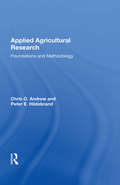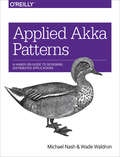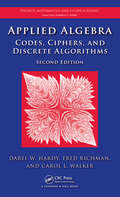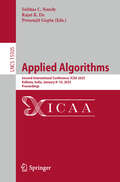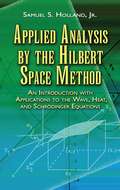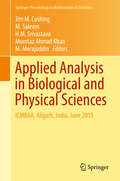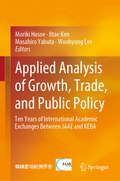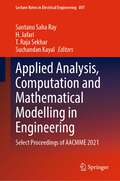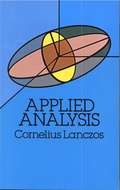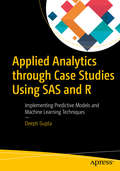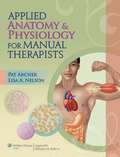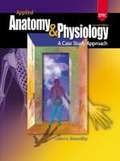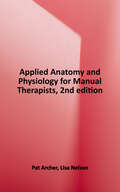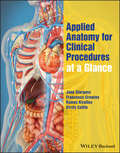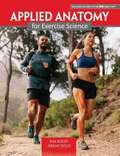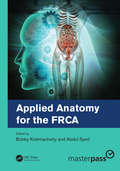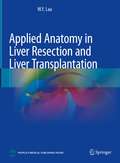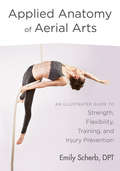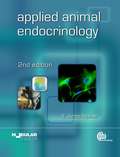- Table View
- List View
Applied Agricultural Research: Foundations And Methodology
by Chris O AndrewThe desire to resolve problems through pragmatic observation, systematic evaluation, and coordinated action persists with each new generation of researchers. A timeless task that bears individual, social, and often cultural characteristics, problem resolution is essentially an experiential process. Routine and methodology can enhance both its proce
Applied Akka Patterns: A Hands-On Guide to Designing Distributed Applications
by Michael Nash Wade WaldronWhen it comes to big data processing, we can no longer ignore concurrency or try to add it in after the fact. Fortunately, the solution is not a new paradigm of development, but rather an old one. With this hands-on guide, Java and Scala developers will learn how to embrace concurrent and distributed applications with the open source Akka toolkit. You’ll learn how to put the actor model and its associated patterns to immediate and practical use.Throughout the book, you’ll deal with an analogous workforce problem: how to schedule a group of people across a variety of projects while optimizing their time and skillsets. This example will help you understand how Akka uses actors, streams, and other tools to stitch your application together.Model software that reflects the real world with domain-driven designLearn principles and practices for implementing individual actorsUnlock the real potential of Akka with patterns for combining multiple actorsUnderstand the consistency tradeoffs in a distributed systemUse several Akka methods for isolating and dealing with failuresExplore ways to build systems that support availability and scalabilityTune your Akka application for performance with JVM tools and dispatchers
Applied Algebra and Number Theory
by Gerhard Larcher Friedrich Pillichshammer Arne Winterhof Chaoping XingHarald Niederreiter's pioneering research in the field of applied algebra and number theory has led to important and substantial breakthroughs in many areas. This collection of survey articles has been authored by close colleagues and leading experts to mark the occasion of his 70th birthday. The book provides a modern overview of different research areas, covering uniform distribution and quasi-Monte Carlo methods as well as finite fields and their applications, in particular, cryptography and pseudorandom number generation. Many results are published here for the first time. The book serves as a useful starting point for graduate students new to these areas or as a refresher for researchers wanting to follow recent trends.
Applied Algebra: Codes, Ciphers and Discrete Algorithms, Second Edition (Discrete Mathematics and Its Applications)
by Darel W. Hardy Fred Richman Carol L. WalkerUsing mathematical tools from number theory and finite fields, Applied Algebra: Codes, Ciphers, and Discrete Algorithms, Second Edition presents practical methods for solving problems in data security and data integrity. It is designed for an applied algebra course for students who have had prior classes in abstract or linear algebra. While the content has been reworked and improved, this edition continues to cover many algorithms that arise in cryptography and error-control codes. New to the Second Edition Downloadable resources containing an interactive version of the book that is powered by Scientific Notebook®, a mathematical word processor and easy-to-use computer algebra system New appendix that reviews prerequisite topics in algebra and number theory Double the number of exercises Instead of a general study on finite groups, the book considers finite groups of permutations and develops just enough of the theory of finite fields to facilitate construction of the fields used for error-control codes and the Advanced Encryption Standard. It also deals with integers and polynomials. Explaining the mathematics as needed, this text thoroughly explores how mathematical techniques can be used to solve practical problems. About the AuthorsDarel W. Hardy is Professor Emeritus in the Department of Mathematics at Colorado State University. His research interests include applied algebra and semigroups.Fred Richman is a professor in the Department of Mathematical Sciences at Florida Atlantic University. His research interests include Abelian group theory and constructive mathematics.Carol L. Walker is Associate Dean Emeritus in the Department of Mathematical Sciences at New Mexico State University. Her research interests include Abelian group theory, applications of homological algebra and category theory, and the mathematics of fuzzy sets and fuzzy logic.
Applied Algorithms: Second International Conference, ICAA 2025, Kolkata, India, January 8–10, 2025, Proceedings (Lecture Notes in Computer Science #15505)
by Rajat K. De Prosenjit Gupta Subhas C. NandyThis book LNCS constitutes the refereed proceedings of the Second International Conference on Applied Algorithms, ICAA 2025, held in Kolkata, India, during January 8–10, 2025. The 26 full papers and 4 short papers are carefully reviewed and selected from 93 submissions. This conference sought original contributions related to the design, analysis, implementation, and experimental evaluation of efficient algorithms and data structures for problems.
Applied Analysis by the Hilbert Space Method: An Introduction with Applications to the Wave, Heat, and Schrödinger Equations
by Samuel S. Holland Jr.Numerous worked examples and exercises highlight this unified treatment of the Hermitian operator theory in its Hilbert space setting. Its simple explanations of difficult subjects make it accessible to undergraduates as well as an ideal self-study guide.Featuring full discussions of first and second order linear differential equations, the text introduces the fundamentals of Hilbert space theory and Hermitian differential operators. It derives the eigenvalues and eigenfunctions of classical Hermitian differential operators, develops the general theory of orthogonal bases in Hilbert space, and offers a comprehensive account of Schrödinger's equations. In addition, it surveys the Fourier transform as a unitary operator and demonstrates the use of various differentiation and integration techniques.Samuel S. Holland, Jr. is a professor of mathematics at the University of Massachusetts, Amherst. He has kept this text accessible to undergraduates by omitting proofs of some theorems but maintaining the core ideas of crucially important results. Intuitively appealing to students in applied mathematics, physics, and engineering, this volume is also a fine reference for applied mathematicians, physicists, and theoretical engineers.
Applied Analysis in Biological and Physical Sciences: ICMBAA, Aligarh, India, June 2015 (Springer Proceedings in Mathematics & Statistics #186)
by Jim M. Cushing H. M. Srivastava M. Saleem Mumtaz Ahmad Khan M. MerajuddinThe book contains recent developments and contemporary research in mathematical analysis and in its application to problems arising from the biological and physical sciences. The book is of interest to readers who wish to learn of new research in such topics as linear and nonlinear analysis, mathematical biology and ecology, dynamical systems, graph theory, variational analysis and inequalities, functional analysis, differential and difference equations, partial differential equations, approximation theory, and chaos. All papers were prepared by participants at the International Conference on Recent Advances in Mathematical Biology, Analysis and Applications (ICMBAA-2015) held during 4-6 June 2015 in Aligarh, India. A focal theme of the conference was the application of mathematics to the biological sciences and on current research in areas of theoretical mathematical analysis that can be used as sophisticated tools for the study of scientific problems. The conference provided researchers, academicians and engineers with a platform that encouraged them to exchange their innovative ideas in mathematical analysis and its applications as well as to form interdisciplinary collaborations. The content of the book is divided into three parts: Part I contains contributions from participants whose topics are related to nonlinear dynamics and its applications in biological sciences. Part II has contributions which concern topics on nonlinear analysis and its applications to a variety of problems in science, engineering and industry. Part III consists of contributions dealing with some problems in applied analysis.
Applied Analysis of Growth, Trade, and Public Policy: Ten Years of International Academic Exchanges Between JAAE and KEBA
by Woohyung Lee Moriki Hosoe Iltae Kim Masahiro YabutaThis book analyzes the various problems of growth, trade and public policy from the perspective of applied economics, based on research in areas such as public policies, trade and regulation, and development economics. Part 1 investigates the broad problems of growth and regional economy, focusing on economic developments in Japan and Korea. Part 2 discusses trade and foreign investment in Japan, mainly on an empirical basis. Part 3 then examines various public economic policies using applied analysis tools. The papers in this volume have been collected to commemorate ten years of academic exchange between the Japan Association for Applied Economics (JAAE) and the Korean Economics and Business Association (KEBA), and include an applied economic analysis of growth and trade in Korea and Japan.
Applied Analysis, Computation and Mathematical Modelling in Engineering: Select Proceedings of AACMME 2021 (Lecture Notes in Electrical Engineering #897)
by Santanu Saha Ray H. Jafari T. Raja Sekhar Suchandan KayalThis book is a compendium of the proceedings of the International Conference on Applied Analysis, Computation, and Mathematical Modelling in Engineering (AACMME-2021). The book covers a variety of applications such as mechanical, acoustical, physical, electrical, bio-mathematical, and computational fluid dynamics. Since mathematical modeling necessitates a wide range of skills and methods, the book concentrates on techniques that will be of specific interest to engineers, scientists, and those who work with discrete and continuous systems models. This book guides students, researchers, and professionals through the new approaches, the powerful tools for quickly mastering the most popular mathematical and computational models used in engineering and science. These new approaches enable readers to not only systematically create effective models, but also extend these models to any macroscopic physical structure.
Applied Analysis: Prentice Hall Mathematics Series (Dover Books on Mathematics)
by Cornelius LanczosThis is a basic text for graduate and advanced undergraduate study in those areas of mathematical analysis that are of primary concern to the engineer and the physicist, most particularly analysis and design of finite processes that approximate the solution of an analytical problem. The work comprises seven chapters:Chapter I (Algebraic Equations) deals with the search for roots of algebraic equations encountered in vibration and flutter problems and in those of static and dynamic stability. Useful computing techniques are discussed, in particular the Bernoulli method and its ramifications.Chapter II (Matrices and Eigenvalue Problems) is devoted to a systematic development of the properties of matrices, especially in the context of industrial research.Chapter III (Large-Scale Linear Systems) discusses the "spectroscopic method" of finding the real eigenvalues of large matrices and the corresponding method of solving large-scale linear equations as well as an additional treatment of a perturbation problem and other topics.Chapter IV (Harmonic Analysis) deals primarily with the interpolation aspects of the Fourier series and its flexibility in representing empirically given equidistant data.Chapter V (Data Analysis) deals with the problem of reduction of data and of obtaining the first and even second derivatives of an empirically given function — constantly encountered in tracking problems in curve-fitting problems. Two methods of smoothing are discussed: smoothing in the small and smoothing in the large.Chapter VI (Quadrature Methods) surveys a variety of quadrature methods with particular emphasis on Gaussian quadrature and its use in solving boundary value problems and eignenvalue problems associated with ordinary differential equations.Chapter VII (Power Expansions) discusses the theory of orthogonal function systems, in particular the "Chebyshev polynomials."This unique work, perennially in demand, belongs in the library of every engineer, physicist, or scientist interested in the application of mathematical analysis to engineering, physical, and other practical problems.
Applied Analytics through Case Studies Using SAS and R: Implementing Predictive Models and Machine Learning Techniques
by Deepti GuptaExamine business problems and use a practical analytical approach to solve them by implementing predictive models and machine learning techniques using SAS and the R analytical language. This book is ideal for those who are well-versed in writing code and have a basic understanding of statistics, but have limited experience in implementing predictive models and machine learning techniques for analyzing real world data. The most challenging part of solving industrial business problems is the practical and hands-on knowledge of building and deploying advanced predictive models and machine learning algorithms. Applied Analytics through Case Studies Using SAS and R is your answer to solving these business problems by sharpening your analytical skills. What You'll Learn Understand analytics and basic data concepts Use an analytical approach to solve Industrial business problems Build predictive model with machine learning techniquesCreate and apply analytical strategiesWho This Book Is ForData scientists, developers, statisticians, engineers, and research students with a great theoretical understanding of data and statistics who would like to enhance their skills by getting practical exposure in data modeling.
Applied Anatomy & Physiology for Manual Therapists (1st Edition)
by Pat Archer Lisa A. NelsonApplied Anatomy & Physiology for Manual Therapists is a clear, accurate, simple, and comprehensive A&P textbook that addresses the needs of students in manual therapy education programs. It is a focused text that deliberately emphasizes the information manual therapists need to be familiar with in order to understand the benefits, effects, indications, and contraindications of their specific form of manual therapy.
Applied Anatomy and Physiology for Manual Therapists
by Lisa A. Nelson Patricia A. ArcherNot many textbooks can make critical anatomy and physiology (A & P) information engaging and accessible for massage therapy learners, but Applied Anatomy & Physiology for Manual Therapists pulls it off beautifully. This premier textbook explores everything manual therapy students need to know about A & P-in ways they can easily understand and apply to their hands-on work. Uniquely relevant and engaging Applied Anatomy & Physiology for Manual Therapists makes A & P principles personally meaningful for students by answering the questions "Why is it critical for me to learn this information?" and "How will it help me become a better manual therapist?" Crucial for safe and informed practice This trusted resource dives deep into need-to-know content, explaining the benefits, effects, indications, and contraindications of specific forms of manual therapy-preparing students to treat clients safely and effectively. <p><p>Practical details to enhance retention of A & P principles: Each chapter contains engaging, classroom-tested content to improve retention of A & P knowledge from classroom to clinic: Manual Therapy Applications highlight subjects most relevant to students' future profession, such as the intricacies of the myofascial network. Pathology Alerts describe common conditions encountered in manual therapy and ways the body systems respond to treatment. BTW boxes contain intriguing A & P facts that deepen students' understanding. What Do You Think? questions bridge the gaps between A & P concepts and manual therapy. Complimentary student resources available. See inside cover for details. Book jacket.
Applied Anatomy for Anaesthesia and Intensive Care
by Andy Georgiou FRCA DICM EDIC FFICM Chris Thompson FRCA EDRA James Nickells Frca Andy Georgiou FRCA DICM EDIC FFICM Chris Thompson FRCA EDRAApplied Anatomy for Anaesthesia and Intensive Care is an invaluable tool for trainee and practiced anaesthetists and intensive care physicians seeking to learn, revise and develop their anatomical knowledge and procedural skills. Concise textual descriptions of anatomy are integrated with descriptions of procedures that are frequently performed in anaesthesia and intensive care, e.g. nerve blocks, focussed echo, lung ultrasound, vascular access procedures, front of neck airway access and chest drainage. The text is supported by over 200 high-quality, colour, anatomical illustrations, which are correlated with ultrasound, fibreoptic and radiological images, allowing the reader to easily interpret nerve block sonoanatomy, airway fibreoptic images and important features on CT and MRI scans. Useful mnemonics and easily reproducible sketch diagrams make this an essential resource for anyone studying towards postgraduate examinations in anaesthesia and intensive care medicine.
Applied Anatomy for Clinical Procedures at a Glance (At a Glance)
by Jane Sturgess Ramez Kirollos Francesca Crawley Kirsty CattleApplied Anatomy for Clinical Procedures at a Glance is a concise resource combining high-quality images and step-by-step instructions to provide expert guidance on the major core training pathways in medicine, surgery and anaesthesia. Written by an experienced team of Foundation Training programme directors and clinical skills examiners, this unique revision and learning guide aligns with training pathways rather than anatomical area to support Foundation doctors and core trainees master these vital clinical procedures. Succinct yet thorough descriptions of each procedure include photographs of surface anatomy, line diagrams of the anatomy, instructions on the procedural techniques, and practical tips for performing the procedures safely whilst minimising risks of complications. All major aspects of Foundation procedures and Core training in applied anatomy are covered, including catheterisation, ECGs, central venous cannulation, basic suturing and anastomotic techniques, endotracheal intubation, epidural injection and spinal injection, defibrillation, and many others. Helps Foundation doctors and Core trainees apply their medical school knowledge in clinical settings Explains the common anatomical pitfalls of invasive clinical procedures Features practice questions on anatomy and clinical aspects to aid in preparing for clinical skills examinations Includes sections on aftercare and on specific equipment, including manometers and underwater seals Applied Anatomy for Clinical Procedures at a Glance is ideal for Foundation doctors and Core trainees, as well as medical students, physician’s assistants and surgical scrub practitioners.
Applied Anatomy for Exercise Science
by Kimberly KeeleyApplied Anatomy for Exercise Science is designed to help students develop foundational knowledge in anatomy and physiology. This textbook is not designed to be an inclusive anatomy and physiology resource, but rather a resource for students to utilize during their first year. Students can use this resource to develop an academic mindset while exploring anatomy and physiology concepts.Applied Anatomy for Exercise Science is divided into two parts: lecture content and a laboratory manual. The lecture content is organised into three sections: (1) Introduction to Applied Anatomy, (2) Musculoskeletal System, and (3) Cardiorespiratory System. Each chapter includes relevant content followed by an outline for note taking and worksheets to gauge understanding of essential concepts. The laboratory manual is divided into seven labs and includes resources for students to learn selected bony landmarks and the action, origin, and insertion of 60 muscles. The lab manual also includes worksheets and illustrations to help students gain a deeper understanding of the muscles and bones included in the textbook.
Applied Anatomy for the FRCA
by Bobby Krishnachetty and Abdul SyedApplied Anatomy for the FRCA covers the anatomical knowledge that trainee anaesthetists who are revising for the Primary and Final FRCA exams will need. The topics covered are derived from the FRCA curriculum and include the most up-to-date version of past exam questions, in order to ensure targeted and successful exam revision. The content, illustrations and overall layout of this book ensure that common gaps in anatomical knowledge encountered by FRCA trainees are included. This reference is divided into sections pertaining to anatomical regions: head and neck, thorax, abdomen, spine, and the upper and lower limbs. The topics of importance to anaesthetists are presented under ‘structures’, ‘circulation’ and ‘nervous system’ (with relevance to regional anaesthesia). Each topic is extensively researched and presented in a simple format for maximum retention. This book makes learning and remembering applied anatomy as straightforward as possible. Applied Anatomy for the FRCA supplements the knowledge required by trainee anaesthetists appearing for the FRCA exams. Clinical educators will also find it useful in teaching. It serves as a practical reference for anatomical knowledge at any point in an anaesthetist’s career. About the Editors Dr Bobby Krishnachetty has been a Consultant Anaesthetist at Southend University Hospital since 2010 and a college tutor for six years. She completed her diploma in medical education and is the author of The Final FRCA Structured Oral Examination: A Complete Guide. She is also the organiser of the regional teaching for Core trainees in the East of England school of anaesthesia, as well as Founder of the ‘Southend Viva Club’ Primary and Final FRCA SOE revision courses for more than nine years, and Cofounder of MRCS OSCE webinars. Mr Abdul Syed has been a Consultant Surgeon at Southend University Hospital since 2015. He is Lead for postgraduate teaching of surgical trainees, Cofounder of MRCS OSCE webinars and conducts Core surgical trainee interview skills courses. Mr Syed is also an Assessor for medical school interviews and an active participant in QI projects and research.
Applied Anatomy in Liver Resection and Liver Transplantation
by W.Y. LauThis book has 20 chapters which cover a full range of knowledge about liver anatomy before one embarks on carrying out a liver operation on a patient. The knowledge ranges from external to internal anatomy of the liver, from pure anatomy to its application in liver operations, from vascular infiow/outflow of the liver to techniques used in reducing intraoperative blood loss, from Couinaud's liver segments to segment- based liver resection, and from the different approaches to liver resectional techniques to the different types of liver transplantation. The particular feature of this book is the heavy use of diagrams which makes reading easier. Surgeons in liver resection and liver transplantation in will find this book of value as a reference book.
Applied Anatomy of Aerial Arts: An Illustrated Guide to Strength, Flexibility, Training, and Injury Prevention
by Emily ScherbAn illustrated guide to anatomy and biomechanics for aerialists who want to optimize their performance and train safelySpecifically designed for aerialists—including those who do trapeze, silks, and other aerial arts— Applied Anatomy of Aerial Arts is an invaluable resource for those who want to optimize their performance and train safely. Using a biomechanical and movement-based approach, Emily Scherb—a physical therapist who specializes in the care, treatment, and education of circus performers—explains the anatomical rationale for progressions of learning and demonstrates simple movements to achieve the coordination, muscular control, strength, and fitness to hang with correct form, how to progress from hanging into a pull up, an inversion, and beyond with a strong center, precise muscle sequencing, and ease of movement. Aerialists will learn how bones, joints, muscles, and soft tissues allow for specific movements and gain an appreciation for concepts of proximal stability. This full-color illustrated guide lays a solid foundation for beginners and advanced students with a wealth of insights into their own performance as well as refreshers on fundamentals in warm ups and conditioning. It explains how to structure a training session, how to care for injuries, and best practices for basic self first aid.
Applied Animal Endocrinology
by E. James SquiresThis textbook explains the role of hormones in improving and monitoring the production, performance, reproduction, behaviour and health of animals. With its focus on livestock animals: cattle, pigs, sheep and horses as well as poultry and fish; the book uses an integrative approach to cover endocrine concepts across species. This updated edition is expanded to include new topics in each section, with updated references, revised study questions and an expanded subject index. It is an essential text for students in animal and veterinary sciences as well as those in academia and industry that are interested in applications of endocrinology in animal production systems. Praise for the first edition: '...a useful text for teaching purposes and an important reference for those who seek ready access to information on specific aspects of applied endocrinology.' Poultry Science
Applied Animal Endocrinology
by E. James SquiresThis book explains the role of hormones in improving and monitoring the production, performance, reproduction, behaviour and health of livestock animals, focusing on cattle, pigs, sheep, horses, poultry and fish. Beginning with the principles of endocrinology and the methods to study endocrine systems, it then covers the different endocrine systems that affect different aspects of animal production and describes how these systems can be manipulated or monitored to advantage. The mechanism of action is covered, and common mechanisms and themes highlighted in order to understand potential methods for altering these systems, and stimulate ideas for the development of new methods. A refreshed, updated resource that highlights new areas of endocrinology with applications in commercial animals, additions to this new edition include: - information on G protein receptors, function of CREB, methods for identification of DNA regulatory sequences and DNA binding proteins, circadian rhythm and the biological clock; - expanded coverage of in vitro models to include 3D cell culture and organ-on-a-chip; - new knowledge on gene editing, antibody production, hormone delivery methods and DNA cloning and sequencing methods; - the role of the gut microbiome, as well as effects of antibiotics and antimicrobials; - skin as an endocrine organ and related information on wool production and endocrine defleecing; - updated information on protocols for assessing endocrine disruptor chemicals. An invaluable text for students of animal science and veterinary medicine, this book also provides a useful resource for those in academia and industry interested in applications of endocrinology in animal production systems.
Applied Anthropology in Canada
by Edward J. HedicanAnthropologists are often reluctant to present their work relating to matters of a broad social context to the wider public even though many have much to say about a range of contemporary issues. In this second edition of a classic work in the field, Edward J. Hedican takes stock of Anthroplogy's research on current indigenous affairs and offers an up-to-date assessment of Aboriginal issues in Canada from the perspective of applied Anthropology. In his central thesis, Hedican underlines Anthropology's opportunity to make a significant impact on the way Aboriginal issues are studied, perceived, and interpreted in Canada. He contends that anthropologists must quit lingering on the periphery of debates concerning land claims and race relations and become more actively committed to the public good. His study ranges over such challenging topics as advocacy roles in Aboriginal studies, the ethics of applied research, policy issues in community development, the political context of the self-government debate, and the dilemma of Aboriginal status and identity in Canada. Applied Anthropology in Canada is an impassioned call for a revitalized Anthropology - one more directly attuned to the practical problems faced by First Nations peoples. Hedican's focus on Aboriginal issues gives his work a strong contemporary relevance that bridges the gap between scholarly and public spheres.
